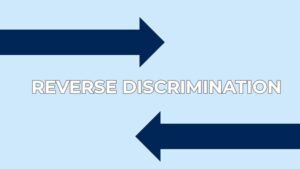Many companies have announced specific hiring goals in response to heightened awareness of racial and gender inequalities. But some of those goals are now being challenged as impermissible “reverse discrimination” as white male applicants are rejected in favor of persons of color or women.
Recent lawsuits have shed light on how Diversity Equity, and Inclusion (DEI) programs may conflict with federal or state EEO (equal employment opportunity) laws. A federal jury in North Carolina awarded $10 million to a white male executive of Novant Health who claimed he lost his job due to efforts to diversify top leadership positions. In a similar vein, an in-house lawyer with Electrolux sued, claiming he was denied a promotion to General Counsel due to a diversity initiative with an expressed preference for sex/gender as a “distinguishing and beneficial characteristic.” And a white male based his reverse discrimination claim against the city of Springfield, Illinois on the Mayor’s statement that hiring a black colleague exemplified his administration “moving towards reflecting the city demographics.”
The Supreme Court and the Equal Employment Opportunity Commission have approved voluntary affirmative action efforts by private employers under limited circumstances. However, in order to comply with federal anti-discrimination laws, an employer’s voluntary affirmative action policy must meet all three requirements established in two Supreme Court cases: United Steelworkers of America, AFL-CIO-CLC v. Weber (1979) and Johnson v. Transportation Agency (1987). Specifically, the affirmative action: (1) must seek to remedy “conspicuous racial [or gender] imbalances in traditionally segregated job categories;” (2) cannot “unnecessarily trammel the interests of white [or male] employees [or applicants]” by, for example, barring whites or males from employment; establishing quotas or inflexible goals; or requiring the discharge or layoff of white or male employees; and (3) must be a temporary measure designed to correct a manifest imbalance, rather than to maintain a particular racial or gender balance.
Interestingly, one of the decisions most often cited to support “reverse discrimination” claims of white employees was authored by Justice Thurgood Marshall, the famed civil rights litigator and first African American Supreme Court Justice. In McDonald v. Santa Fe Trail Transportation Co. (1976), the Court ruled that the railroad engaged in unlawful race discrimination by firing two white employees for cargo theft, while retaining a Black employee charged with the same offense. Writing for the majority, Justice Marshall reasoned that “racial discrimination in private employment against whites [must be] on the same terms as racial discrimination against nonwhites,” and denounced “the illogic in retaining guilty employees of one color while discharging those of another color.”
Companies also run the risk that diversity training may itself be used as evidence of reverse discrimination. A set of slides at a Coca-Cola diversity training read: “Try to be less white” and “To be less white is to be less oppressive, less arrogant, less certain.” Similarly, the city of Seattle’s Office of Civil Rights sent an e-mail inviting “white city employees” to attend a training session on “Interrupting Internalized Racial Superiority and Whiteness,” a program designed to help white workers examine their “complicity in . . . white supremacy” and “interrupt racism in ways that are accountable to black, indigenous and people of color.” Progressive intentions aside, this type of labeling could be viewed as racially antagonistic and potentially support claims by white employees or applicants alleging a discriminatory preference in favor of persons of color.
To some, the very concept of “reverse discrimination” is offensive given the systemic advantages of white persons. Professor Ibram Kendi, author of How to be an Antiracist, a #1 New York Times Bestseller, advocates that “the only remedy to racist discrimination is antiracist discrimination.” While Professor Kendi’s insight might make sense from a public policy perspective, employers should be aware that a good faith attempt to mandate a threshold number of diverse hires may be inviting potential claims of reverse discrimination.
Only time will tell whether corporate attempts at inclusion and diversity lead to a surge in reverse discrimination cases. The crucial macro social goal of identifying and remedying discrimination and inequity has the potential to play out differently at the micro level, in litigation challenging a preferential selection in hiring or promotion due to race or gender. Stay tuned as there will surely be more interesting litigation ahead.
_____________________________________________________________________________
This article was published in Smerconish on date May 17,2023.




